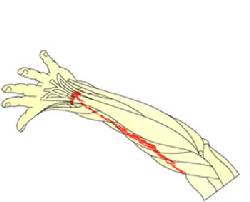The Crucifixion Of Jesus
The Nailing Of The Wrists
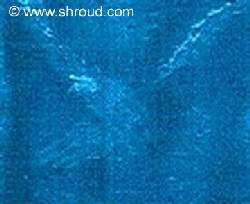
A close-up of the hands on the Shroud raises two crucial questions:
- Why is the blood on the Shroud coming from the wrist and not the palms, as mediaeval paintings depict?
- Where are the thumbs?
On the Shroud the blood is clearly coming from a wound in the wrists, and the thumbs are not present on the image. Anatomical studies have demonstrated that a nail through the palm of a crucified body would tear through the flesh, because the palm of the hand is a strong enough structure to support the full weight of the human body. Mediaeval artists obviously did not know this anatomical fact, and this is one more proof of the authenticity of the Shroud.
Destot’s Space in the bones of dorsum of the wrist
The nailing of the hands
Examination of the area of the hands on the Shroud shows the left hand over the right hand (remember the image is transposed in a photo – negative image). There is also a puncture wound in both wrists, from which blood is seeping, draining up both forearms on the Shroud.
In mediaeval paintings the nails were always painted inserted into the palms, rather than the wrists. Experiments on dead bodies shows that the weight of a human body cannot be supported by nails through both palms.
As the Shroud clearly shows, the nails were in fact inserted through the wrist, through a small depression easily palpable on the dorsum of the wrist known as “Destot’s point”. If you carefully feel on the dorsum (the back) of your own wrist, you will feel a depression approximately 10 cm proximal to the base of the dorsum of the middle finger, in an adult male hand. Crucifixion was normally reserved only for men.
The Roman soldiers were very skilled at Crucifixion, and searched for this exact point. The nails would have passed directly through the Median nerve in the Carpal Tunnel, causing excruciating pain.
As can be clearly seen on the Shroud, the thumbs appear to be missing from both hands. There is a reason for this, as explained below.
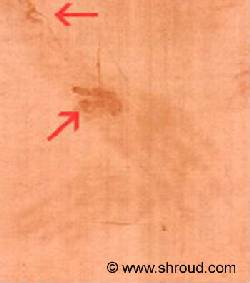 |
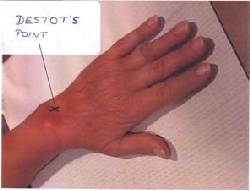 |
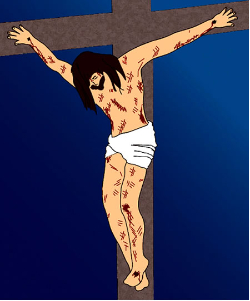 |
Drawn by Sarah Kent
The position of the arms on the Cross
We believe that the correct position of the arms on the Cross is as shown, with the palms against the wood of the Cross (the Patibulum) and the thumbs pointing downwards.
Blood flow from Destot’s Point, down the forearm, (from medial to lateral)
Traditionally the Crucifixion has always been displayed with the nails passing though the palms, and the dorsum of the hand against the crossbar. This is not correct. The blood flow from the wounds in the wrists shows that when the arms were placed on the Cross, they were placed with the palms against the wood of the Cross, with both thumbs pointing downwards.
The blood trails can be clearly seen with the blood flowing on the dorsum (the back) of the forearms, from medial to lateral (on the back of the forearm, this is from the side of the forearm with the little finger, to the side of the forearm with the thumb. Try it on yourself!)
The blood flows from the injuries in the wrist indicate that the victim died with His hands raised about 65 degrees from the horizontal on the Cross. (To define medial and lateral, in the “anatomical position” the palms are facing forward).
In the blood flows shown in the picture, the blood on the dorsum of both forearms is clearly tracking from medial to lateral. The only way this could have occurred is if the arms were positioned on the Cross with palms against the wood of the Cross, with both thumbs pointing down to the feet, and the nails hammered into Destot’s points.
The significance of this is that after six hours on the Cross, the weight of Jesus’ body would have dislocated His shoulders, elbows and wrists. Jesus died with His body supported by both arms, raised about 65 degrees from the horizontal. The arms are six inches longer than normal on the Shroud, due to the dislocations.
In addition, Jesus’ body weight would have forcibly flexed both thumbs into the palms, and Jesus’ hands would have adopted a “claw” position. This is the reason why the thumbs are not seen on the Shroud. It is inconceivable that a mediaeval forger would be familiar with these anatomical details, which are certainly not well understood today, judging by all the anatomically incorrect images of the Crucifixion.
The blood flow seen on the Shroud indicates that Jesus was nailed to the Cross with His palms against the wood of the Cross – unlike every image ever seen. The blood flow from the wounds in the wrist are down the lateral aspects of both radius bones. If Jesus’ wrists had been nailed to the Cross in the traditional position, the blood flow would have been down the medial surfaces of both ulnar bones – but it is not.
